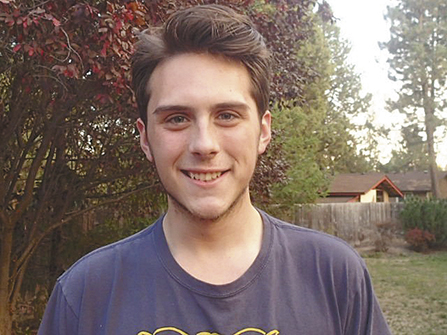Walking through the Summit High School commons, it’s hard to find a student opposed to the legalization of recreational marijuana.
Statements are similar from table to table. One sophomore girls says she’s never tried it, but that she doesn’t see the harm in legalization. One senior boy, who’s backwards five-panel hat and torn board shorts suggest a level of pot-head stereotype that borders on pastiche, grins broadly and declares that if he lived in Colorado he would smoke weed everyday (as if he doesn’t already).
The affirmations run the gamut from tentative to confident, bordering on zealous, but the consensus among Central Oregon teenagers seems to be that pot, in varying degrees of moderation, is perfectly okay.
That teenagers are open to marijuana should come as a surprise to no one. My generation is coming of age in an increasingly liberal time, all things considered. We developed our worldviews to the soundtrack of a conservative presidency running aground and gleaned our mores from shows like Mad Men, Parenthood and How I Met Your Mother, which far from glorifying or damning pot use, present it as commonplace or with indifference.
As people have warmed to the drug, so has society, and as society has grown in acceptance, so have the people within it.
By the Numbers
Liberal youth aside, the State of Oregon is still split on the issue. In November, when the Oregon Legalized Marijuana Initiative (Measure 91) comes to a vote, current polling shows 51 percent of voters in support, 41 percent in opposition, and a crucial 10 percent undecided.
Marijuana legalization makes sense: looking at Colorado, it doesn’t seem that legalization has caused a significant spike in overall usage, and while the number of drivers in fatal accidents who tested positive for pot has risen, these positive results come from metabolites in blood or urine, which can linger for over a month after drug use. Considering the immeasurable amount of money that could be saved on law enforcement, and the $55 million that Oregon could stand to gain in revenue, the cost of legalization seems like a bargain at twice the price.
Obviously, marijuana is a potent and potentially dangerous drug, but so are alcohol (which leads to significantly higher impairment in terms of driving and psychomotor skills and can lead to death from overdose) and cigarettes (which are proven to be more carcinogenic then pot), both of which are legal. Increased driving under the influence and rising addiction would be an issue if Measure 91 invented marijuana, but over 14.5 percent of Oregonians already use or have used the drug. Only four percent of the total population reported that they refrained from pot simply for legal reasons, which means that for the most part, those interested in smoking it already do.
Youth Perspective
In talking to other teenagers, one thought that occurred to me was that in legalizing marijuana, it’s possible that the state might nullify a relatively safe method of rebellion. According to several of my peers, a major reason that some kids smoke or drink is that it’s forbidden and therefore utterly alluring. Another friend told me that many of his friends in Washington no longer smoke because now that “everybody can get it” marijuana just “isn’t as cool anymore.” While at first this may seem like a good thing, it’s important to remember a universal constant: teenagers rebel. If the big rebellion is no longer smoking, many teenagers I spoke to say that they could see some kids getting into substances which are far worse, or at least far more illegal.
The largest group of teenage pot users, however, are kids who use it recreationally and non-habitually for the obvious but often overlooked reasons. With all the talk of medical uses and addiction, it’s important to remember that the most common motivations for pot use, at least among the teenagers I’ve talked to, are simply that it’s fun and feels good, just like any other substance.
Of course, teenagers and younger people are among the few demographics who may be effected negatively by the drug in ways that can be permanent and identifiable. Heavy use has been shown to reduce drive and slow cognitive function in teens for days after use. Any smoke has negative effects on the lungs of those who inhale it, and teenagers and younger people have more sensitive lungs to begin with. And of course, though the same can be said of any leisure activity, any time spent high or in search of marijuana is time not spent on schoolwork, planning for the future or other more productive pursuits.
These reasons have resulted in the fact that while me and my over-18 year old peers can vote to pass Measure 91, we won’t be able to enjoy its outcome until we turn 21. For this reason alone, even if the measure passes, I don’t expect all that much to change, at least not for the youngest of us.
Uncertain Future
Just like with any such experiment, we can’t truly be sure of what will happen until after the fact. One salient truth, however, is that the way pot is currently regulated isn’t sustainable. Current policies have led to massive government spending with minimal results, a system of punishment which is “3.7 times more likely” to arrest a black person than a white person despite comparable usage rates, and thousands upon thousands of lives radically changed by prosecution for use and/or possession of an arbitrarily prohibited plant.
Beyond these systemic problems, the oldest arguments ring the truest: pot is fun, possesses documented health benefits when used in moderation to treat chronic symptoms, and, compared to many legal drugs such as alcohol, nicotine and salvia, is relatively safe. This is Oregon, home of The Country Fair, Ken Kesey and his merry pranksters, and year round Birkenstocks: the people who want to smoke cannabis are already doing it.
With that the case, it only makes sense that the state should try to make revenue off of it, especially since under measure 91, at least 40 percent of the revenue would go to Oregon’s critically underfunded schools.
Morgan Doyscher is a senior at Summit High School in Bend, Oregon and currently an editorial assistant intern at Cascade Publications Inc.





